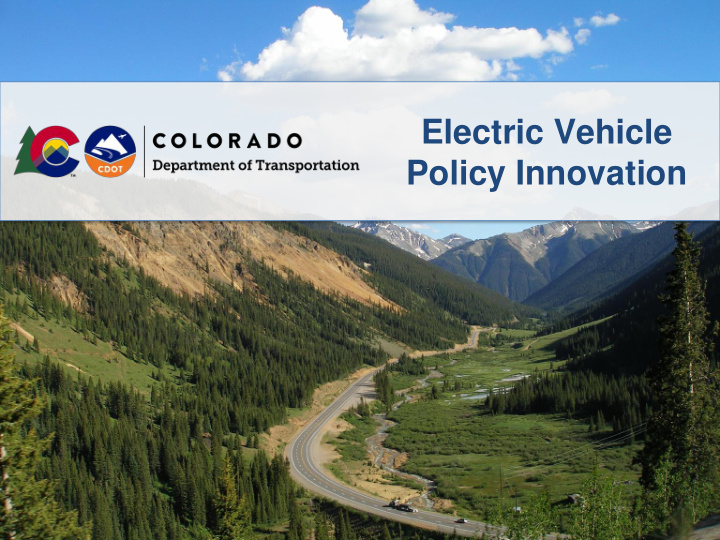



Electric Vehicle Policy Innovation
Electrification Programs Planning Efforts Funding Programs FAST Act Alt Fuels Alternative Fuel Colorado Corridors Charge Ahead Colorado EV Plan Colorado Volkswagen REV West Settlement A sustainable statewide alternative fuels market
Recent Developments • Increasing variety of brands and models available in Colorado • Colorado ZEV Rule approved in August 2019 • Point of Sale tax credit extended through 2026 (with phase out) • Ongoing infrastructure development (public and private) Source: Navigant
Office of Innovative Mobility Reduce pollution in our air and congestion on our roads by expanding multimodal transportation options, utilizing traditional and emerging mobility technologies. Innovative Mobility Mobility Mobility Transit & Rail Electrification Services Technology
Senate Bill 19-239 Emerging Mobility Impact Study
Purpose of SB 19-239 The law directed CDOT to convene a stakeholder group to: “ examine the impacts of technological and business changes related to motor vehicles used for commercial purposes” and to identify means to mitigate negative or promote positive impacts. Impacts to Consider ENVIRONMENTAL ECONOMIC TRANSPORTATION SYSTEM Between May and November 2019, CDOT gathered feedback from nearly 30 appointed stakeholders, inventoried existing fees on covered providers, and modelled potential fee structures and their impacts.
Emerging Mobility Providers Included in SB 19-239 PROVIDER DEFINITION EXAMPLES Transportation A company that relies upon a mobile application to pair riders Uber, Lyft, Hop Skip Network with drivers. Drive Company (TNC) Peer Car Share A car sharing company that enables individuals to rent personal Turo, Drift, vehicles to others. Getaround, Maven Non-Peer Car A car sharing company that operates a fleet of vehicles for use Streetcar, ZipCar, Share by individuals. ShareNow Freedom Cabs, Taxi A company that providers taxicab service. Metro Taxi Enterprise, Avis, Car Rental A company that rents vehicles to individuals. Hertz, Budget A company that relies on a mobile application to pair UberEats, Grubhub, commercial vendors/stores/restaurants to private drivers to Residential AmazonFlex, deliver goods to residential addresses in personally owned or Delivery grocery stores fleet-owned vehicles having a gross vehicle weight rating under delivery 14,000 lbs. 7
Fee Structures Considered Flat Fee Mileage-Based Fee Percentage-Based Fee The same, flat charge The fee is assessed on The fee is a percentage on top of every trip a per-mile basis, of the total fare, daily regardless of length or increasing with the rental charge, or other factors. length of the ride or delivery cost. delivery route. 8
2030 Modeling Results Estimates of the emerging The estimated impacts of fee Forecasts of the emerging mobility industries’ current structures and ZEV mobility industries’ emissions emissions, VMT, and trip infrastructure funding on and VMT in 2030 dynamics 2030 projections • By 2030, the total VMT of emerging mobility providers expected to grow 140% to approximately 11 million (with an estimated range between 5 million and 28 million VMT per day), representing 7% of the state’s total VMT (with an estimated range between 3% and 17%). • Travel behavior and emissions impacts were modeled for each of the fee types (flat, mileage-based, percentage-based) and for a high and low range of rates and elasticities of demand (i.e. the sensitivity of demand to increases in the price of fares). • Based on examples of existing fee levels across the U.S., these forecasted fees generated between $14 - $80 million (including all of the services covered under S.B. 19-239, such as taxis, car rentals, and ride hailing). 9
Forecasted 2030 Trips, VMT, Emissions & Revenue
Graduated Fees to Reflect Intent of SB 19-239 Lowest Fee Discounted Fee Highest Fee Shared AND Zero Zero Emission Solo Ride in Internal Emission Vehicle Vehicle OR Shared Combustion Engine Vehicle 11
Working Group Recommendations The diverse working group came to general agreement that any fees: • Be lower or waived for trips taken in Next Steps: ZEVs, or trips that are shared/pooled. • Consider impacts on social equity, economic development, the availability of transportation options (especially in rural areas), and existing fees levied on emerging mobility providers. • Be flexible enough to adapt to evolving technologies (e.g. autonomous vehicles), business models, and state data collection/enforcement capacities. • Additional data is needed on number of trips for emerging mobility providers including E-commerce/residential deliveries.
Working Group Recommendations The diverse working group came to general agreement that any fees: • Be lower or waived for trips taken in Next Steps: ZEVs, or trips that are shared/pooled. • Consider impacts on social equity, economic development, the availability of transportation options (especially in rural areas), and existing fees levied on emerging mobility providers. • Be flexible enough to adapt to evolving technologies (e.g. autonomous vehicles), business models, and state data collection/enforcement capacities. • Additional data is needed on number of trips for emerging mobility providers including E-commerce/residential To be continued… deliveries.
Working Group Recommendations Link to website with report and appendices: https://www.codot.gov/library /studies/emerging-mobility- impact-study
Contacts Michael King (303) 757-9997 michael.king@state.co.us
Fee Structure Assumptions
Recommend
More recommend